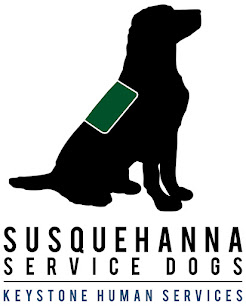You may have seen one—a fake service dog. They’re pets that
have little to no formal training, let alone service dog training. But their
owners wanted to take their dogs everywhere with them, so they hopped online,
bought a service dog vest, and put it on their dog. Now their dog goes with
them to stores, restaurants, movie theaters—everywhere. The dog may bark and
whine in public, eat things off the floor, greet everyone they see, or worse,
lunge at and bite people and legitimate service dogs. Because of the service
dog vest, business owners don’t feel like they can ask the person to remove the
dog. The whole experience makes business owners much less welcoming, and even
hostile, toward legitimate service dog teams.
People think it’s harmless to dress their pet dog in a
service dog vest and go everywhere, but it’s not. It’s hurting real service dog
teams. Sometimes it makes it impossible for the service dog to do its job,
which can be life threatening to the dog’s person. At the very least, it adds
unnecessary stress to people who need service dogs when business owners try to
deny them access.
Many people think that taking a service dog in public is a
right, but it’s actually a law. Under the Americans with Disabilities Act
(ADA), people who have service dogs can take them in public. A service dog can
go anywhere the public can go. Under the ADA, service dogs are equivalent to
medical equipment, and while we may not always like the analogy of comparing
our dogs to equipment, the truth is that the dogs perform specific tasks to
mitigate a person’s disability, much like medical equipment does. In fact, the
dogs can often do tasks for a person that a sophisticated piece of medical
equipment cannot do. For example, hearing dogs alert people to sounds in the
environment, seizure response dogs can get help when their partner has a
seizure, psychiatric service dogs can move in front of a veteran in a crowd to
create space, and balance dogs can act as a counterbalance to help a person
walk and prevent falls.
Few people realize the amount of training that goes into a
single service dog, nor do they realize the high expectations for behavior that
are required of service dogs. When we’re working with our dogs in public, we
often have people tell us that they think their dog would have made a good
service dog. Many people think their dog could be a service dog because their
dog is calm, listens to cues, and likes people or has “a connection” with a
person. However, there is much more to it than that.
Within Susquehanna Service Dogs, training starts from the
moment the puppies are born. The dogs are socialized, and taught self-control,
good house manners, and a wide variety of cues. Once the dog has been trained
by a volunteer puppy raiser for one and a half to two years, the dog comes to
our kennel where our professional trainers take over the job of training the
dogs. Each dog is matched with a person and then trained in specific tasks to
mitigate that person’s disability. Few people realize that it takes
approximately two and a half years of continual training before a service dog
is ready to be placed with a person. And on top of the training, there are also
health and temperament requirements.
A working service dog can calmly handle going into almost
any situation and environment. Ideally, other people should barely notice that
the dog is there. For example, in a restaurant, the dog should go under the
table and lay quietly. Other patrons should not even realize that there is a
dog under the table. In all situations, the dog should be as unobtrusive as
possible.
Back when the ADA was being developed, advocates worked hard
to make the law as broad as possible and to protect the privacy of people with
disabilities. Under the current law, staff and other people are only allowed to
ask a person with a service dog two questions: 1. Is the dog a service animal
required because of a disability? and 2. What work or task has the dog been
trained to perform? No certification or identification is required for service
dogs, nor do they have to even wear a service dog harness.
Because the law is so broad, it’s very easy (though illegal)
for people to pass their pets off as service dogs. As fake service dogs become
more of a problem, some people have suggested making the ADA more
restrictive—requiring dogs to come from accredited organizations or requiring registration
and certification for every service dog. However, we don’t see this as a viable
solution. A more restrictive law would penalize people who have trained their
own dogs. Because the dog doesn’t come from an accredited organization, they
wouldn’t have public access, which would defeat the entire purpose of having a
service dog. And requiring registration and certification would erect
unnecessary barriers for people who are seeking independence.
So, if we don’t want the law to change, what can we do to prevent
the problem of fake service dogs from escalating?
Education is important. People need to understand that every time they
put a service dog harness on their pet, they are affecting the lives of people
who truly need a service dog. Business owners also need to learn their rights
with the ADA. A business can legally ask a person to remove their service dog
if the dog is out of control and the handler doesn’t effectively take action to
control the dog or if the dog is not housebroken. You can read the full ADA
requirements for service animals here.
If you know someone who tries to pass their pet off as a
service dog, please let them know that their actions are hurting others. Please
consider the cost to someone who truly needs a service dog by their side in
order to have their independence.





















